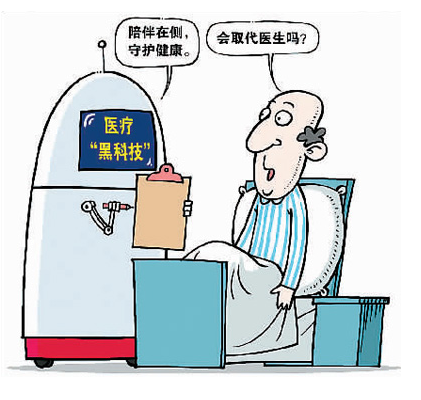Artificial intelligence + medical do not ignite the fire in the wind
In recent years, the concept of “artificial intelligence + medical care †is in the ascendant. One of the recent cases is that Ali Health announced that it will sign a contract with the First Affiliated Hospital of Zhejiang University Medical College to promote smart medical care in areas such as artificial intelligence research and smart hospital construction.

Nowadays, artificial intelligence technology has gradually entered the medical field. For example, some medical institutions have begun to use new medical methods such as guided robots, cloud doctors, and voice electronic medical records to serve patients. A number of provincial and municipal artificial intelligence clinics have been established. Some hospitals and clinics in remote areas can quickly get feedback by transmitting patient case data online to the center. Corresponding to this is the rise of a group of high-tech medical enterprises - data show that there are currently 139 related companies involved in artificial intelligence medical treatment in China.
The advantages of applying artificial intelligence technology to the medical field are obvious. For patients, highly intelligent medical conditions make it easier to see a doctor, and can significantly reduce medical costs and reduce the burden. For doctors, artificial intelligence technology can greatly reduce the risk caused by subjective judgment or operational error, making the diagnosis more Precision. Nowadays, the diagnosis of certain diseases by computers has reached the level of experts, and even "green out of blue." Studies have shown that artificial intelligence algorithms based on machine learning can identify the symptoms of skin cancer based on the patient's imaging examination results, and the recognition rate is higher than the doctor. In the detection of heart rhythm abnormalities by analyzing electrocardiogram, the recognition rate of artificial intelligence is also higher than that of cardiologists.
Some people believe that with the gradual maturity of artificial intelligence technology, a trillion-scale artificial intelligence big health industry is ready to come. The performance of the capital market seems to confirm this judgment. Some companies that focus on the concept of "artificial intelligence + medical" are highly concerned by investors. At the same time, some people in the industry are also worried that these investments will undoubtedly ignite "virtual fire" at the turmoil in the stage of actual application, which is not conducive to the long-term development of the industry.
For the time being, the application of artificial intelligence in the field of medical and health is still in the initial stage of simple integration. There are still many barriers to fully land. For example, in the medical field, “data islands†have always existed. Applying artificial intelligence technology to the medical industry , data processing is key. At the technical level, the application of artificial intelligence technology is mostly reflected in the analysis of image data and data. How artificial intelligence can achieve accurate diagnosis and treatment through direct contact and interaction with patients is still a technical problem. At the same time, the popularity of “artificial intelligence + medical care†is also faced with a series of problems such as the establishment of industry standards, the complete supervision system, and the renewal of social concepts.
At present, the problem of uneven distribution of medical resources in China has not been fundamentally resolved. Most of the high-quality medical resources are concentrated in the top three medical institutions and the economically developed areas in the east. Artificial intelligence technology makes high-precision remote diagnosis and treatment a reality, which contributes to the equalization of medical resources, and is of great significance for solving the problem of many people seeing a doctor and seeing a doctor. At the same time, the expression of “Implementing a Healthy China Strategy†in the report of the 19th National Congress of the Communist Party of China also brought great confidence to the intelligent development of the medical and health industry. Under this circumstance, the “artificial intelligence + medical†industry in the “window†should seize the opportunity, consolidate the foundation, first practice internal strength, and avoid the concept hype driven by short-term profit-seeking. Only in this way can the medical health industry be made. The upgrade development is stable and far-reaching. (People's Daily)
Tof(Time-of-flight), is JRT new product, which is a single-point LiDAR sensor. With a micro size of 46x17x7mm, customers can widely use in many Laser Measurement Solutions. The lidar distance sensor can measure 12m short-range. It's great for Unmanned Aerial Systems.Contact Us Now for data sheet.
| Product Name | Tof LiDAR Sensor |
| Model Number | IT02S-65-A/IT02S-65-B/IT03M-650 |
| Measuring Range (without Reflection) | 0.1-12m/0.1-10m/0.1-15m(90% reflectivity) |
| Place of Origin | China |
| Accuracy | 2cm~4cm/5cm |
| Blind Area | 10cm |
| Resolution | 1cm |
| Measuring Unit | centimetre |
| Laser Class | Class II, red |
| Laser Type | 650nm, <1mW |
| Communication Interface | UART, 115200bps(default) |
| Size | 46*17*7mm/50*26*13mm |
| Weight | About 4g/10g |
| Voltage | 2.7V~+3.6V |
| Electrical Level | TTL/CMOS |
| High Frequency | 100hz |
| Operating Temperature | 0-40 ℃ (32-104 ℉ ) |
| Storage Temperature | -25~60 ℃ (-13~140 ℉) |
ToF Sensor,Time of Flight Sensor,LiDAR Distance Sensor,ToF Distance Sensor
Chengdu JRT Meter Technology Co., Ltd , https://www.accuracysensor.com